|
| For the 1990-1999 period, agriculture production, livestock and farm machinery and equipment were associated with the highest proportionate mortality ratios for asthma. Among the other top five industries with significantly elevated PMRs for asthma were: child day care services; drug stores; and health services, not elsewhere classified. Among the top ten industries associated with significantly elevated PMRs for asthma are two others related to the health care industry: hospitals and offices and clinics of physicians. |
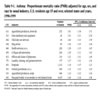 |
| Table 9-1. Asthma: Proportionate mortality ratio (PMR) adjusted for age, sex, and race by usual industry, U.S. residents age 15 and over, selected states and years, 1990-1999 |
|
| For the 1990-1999 period, half of the 23 occupational groups associated with significantly elevated PMRs for asthma were related to health care and education. |
 |
| Table 9-2. Asthma: Proportionate mortality ratio (PMR) adjusted for age, sex, and race by usual occupation, U.S. residents age 15 and over, selected states and years, 1990-1999 |
|
| Public health surveillance programs in four states (California, Massachusetts, Michigan, and New Jersey) have identified over 2,500 cases of work-related asthma over a recent seven-year period (1993-1999). About 80% represented asthma caused by occupational exposure, while 20% represented preexisting |
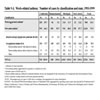 |
| Table 9-3. Work-related asthma: Number of cases by classification and state, 1993-1999 |
|
| Of all the work-related asthma cases from California, Massachusetts, Michigan, and New Jersey associated with various categories of reported putative agents for 1993-1999, 20% were associated with miscellaneous chemicals, 12% with cleaning materials, 11% with mineral and inorganic dust, 10% with indoor air pollutants, and 4% with welding exposures, among others. |
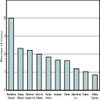 |
| Figure 9-1. Work-related asthma: Most frequently reported agent categories associated with cases of work-related asthma, 1993-1999 |
|
| Based on a recent national survey of the U.S. population in which respondents’ current industry was ascertained, elementary and secondary schools and colleges was the current industry sector associated with an estimated asthma prevalence among nonsmokers that significantly exceeded the estimated 8% prevalence of asthma among all U.S. adult nonsmokers. |
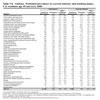 |
| Table 9-8. Asthma: Estimated prevalence by current industry and smoking status, U.S. residents age 18 and over, 2000 |
|
| Based on the survey noted above, teachers, librarians and counselors was the current occupation associated with estimated asthma prevalence among nonsmokers that significantly exceeded the estimated 8% prevalence of asthma among all U.S. adult nonsmokers. |
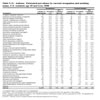 |
| Table 9-11. Asthma: Estimated prevalence by current occupation and smoking status, U.S. residents age 18 and over, 2000 |
|

